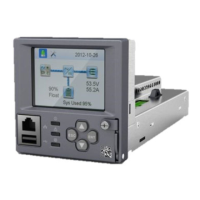Vertiv™ NetSure™ Control Unit (NCU) User Manual
Figure 1.2 Temperature Compensated Voltage Control
Battery Equalize Charge and Battery Charge Current Limit
The NCU can increase system output voltage for equalizing the charge on all battery cells of a conventional flooded cell battery, or for
recharging the battery following a commercial power failure.
The charging function can be initiated cyclically (scheduled), automatically, or manually.
Refer to the battery manufacturer's instructions for equalize charging instructions.
Functional Description (See Figure 1.3
):
• Start of Charging: When the battery charge current exceeds a preset value for three (3) minutes or if the calculated battery
capacity has decreased to a preset value (after a commercial AC failure, for example), the charging function of the NCU is
activated. A charging signal is sent from the NCU to the rectifiers to increase the voltage up to the battery charging level
V
equalize
.
• Battery Current Limitation: After a commercial AC failure or when some battery cells are permanently damaged, the
current to the batteries can be quite extensive. To avoid overheating or further damages to the battery, the NCU limits the
battery current to a preset level by limiting the charging voltage of the rectifiers. Should the battery current still exceed a
higher preset value, an alarm is issued. Battery charge current is limited to the value set in the controller, as long as battery
voltage is above 47 VDC.
• End of Charging: When the charging current drops below a preset value, a defined prolonged charging time is started
before the charging is stopped and the voltage of the rectifiers return to the float charging level (V
nom
). For safety, there is an
equalized charging limit time that stops the charging after a preset time.
Figure 1.3 Voltage Characteristics on Commercial AC Failure and Automatic Equalize Charging
Te
m
pC
om
p
Co
ef
f
se
t
ti
n
g (
mV
/
°C
).
V
nom
T
nom
T
V
nom
V
high
V
low
Upper voltage level where temperature compensation
clamps the voltage. Limited to the TEMP COMP MAX V
setting.
Nominal voltage (voltage at nominal temperature).
Lower voltage level where temperature compensation
clamps the voltage. Limited to the TEMP COMP MIN V
setting.
Nominal temperature (no temperature compensation is done at this temperature).
This is the Temp Comp setting.
1V Max (24V System)
2V Max (48
V System)
1V Max (24V System)
2V Max (48V System)

